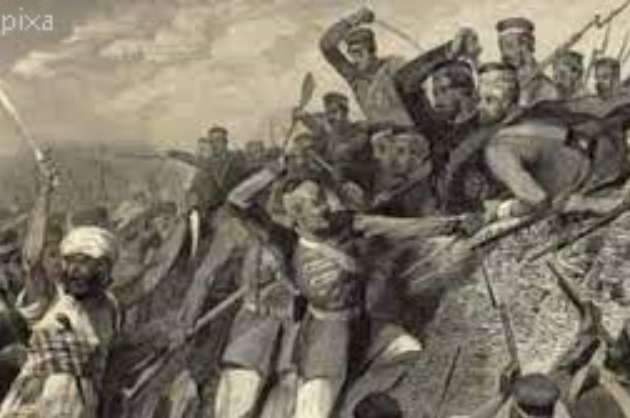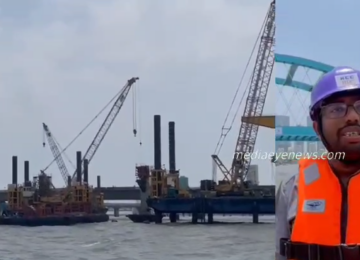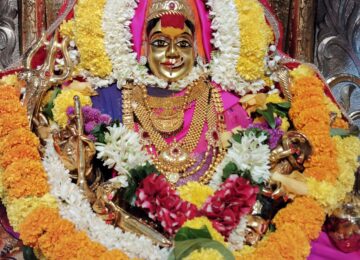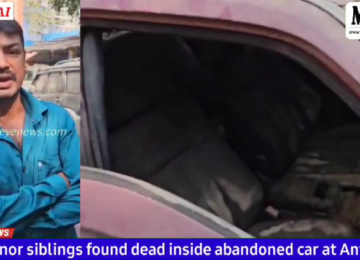Anupama Nair
www.mediaeyenews.com
May is an important month in our history. I don’t know how many of us remember our freedom struggle and the millions of people who sacrificed their lives for Bharat Maa starting from Prithvi Raj Chauhan to Netaji Subash Bose. It is noteworthy to remember, that we were slaves for nearly 900 years and now we are a free nation
Did the sacrifice of the millions go in vain and we have forgotten them and only give credit to two or three people for our independence and the rest are forgotten in the annals of history never to be remembered. Was it for this day, they selflessly sacrificed their life for you and me, children of Independent India? But is it fair to forget them and their sacrifice?
Our great PM Mr. Modi who forgets any day in history tweeted “On this day in 1857 began the historic First War of Independence, which ignited a spirit of patriotism among our fellow citizens and contributed to the weakening of colonial rule. I pay homage to all those who were a part of the events of 1857 for their outstanding courage”. In the month of May i.e., 10th, the Revolt of 1857 or First War of Independence started and succeeded in ending the rule of the East India Company within a year. This revolution has the record for the greatest number of lives lost. The great people who revolted against the Company Raj was Mangal Pandey, Tatya Tope, Nana Saheb, Rani Laksmibai and many others. To understand the revolt, I need to take you back many centuries before.
It is a credit to the British, how the merchants who came to do trade with India, within 300 years became the masters of the entire land from Khyber to Chittagong and from Kashmir to Comorin (now Kanya Kumari), i.e., entire sub-continent. The English East India Company was formed by merchants of England to trade with Asia and India the “golden bird” in particular and America. It was formed by Royal Charter on New Year’s Eve on 1600. They landed in the Indian subcontinent on August 24, 1608, at the port of Surat (Gujarat). The Mughal Emperor Jehangir gave them permission to trade in India.
While India has a rich and recorded history going back 7000 years to the great Indus Valley Civilization in Harappa and Mohenjodaro, but England had no indigenous written language until the beginning of 9th century almost 3000 years after India. Then, how was it possible for the British East India Company to start capturing a huge country like India and control it from 1757 to 1857. Other than India, they ruled over one-sixth of the world, including America (US), Canada, Australia, New Zealand, Malayan Federation and the list goes on… In fact, the empire was called as the “empire where the sun never sets”. It is a credit to India that with our Independence in 1947, the empire crashed and all countries became free one-by-one.
The last Governor General Lord Canning never imagined a rifle would bring the end of East India Company. Let us see how that happened. Soldiers throughout India were issued a new rifle, the Enfield Rifle— a more powerful and accurate weapon than the previous one used for decades. To load both the old musket and the new rifle, soldiers had to bite the cartridge open and pour the gunpowder. Then, the rumor spread the cartridge was greased with the fat of pigs and cows. The news spread like wild fire and the soldiers refused to use the rifle, however, British officers dismissed these claims as rumors and ordered them to use the rifle. Moreover, there was a prophecy that Company Raj would end in a hundred years, which was proved true.
The rebellion started when Mangal Pandey, who was the leader of the Bengal Regiment started the revolt. By March 1857, he was a private soldier (sepoy) in the 5th Company of the 34th Bengal Native Infantry. On the afternoon of 29th March 1857, Lieutenant Baugh, of the 34th Bengal Native Infantry, then stationed at Barrackpore (West Bengal) was informed that several men of his regiment were in an excited state and planned to rebel against the British under the leadership of Mangal Pandey. The British tried to suppress the rebellion and executed Mangal Pandey. “The attack by and punishment of Pandey is widely seen as the opening scene of what came to be known as the Indian Rebellion of 1857”, stated many historians. Mangal Pandey’s rebellion was widespread amongst his fellow soldiers and is assumed to have been one of the factors leading to the general series of rebellion that broke out during the following months. Mangal Pandey inspired many others to follow in the Indian Nationalist Movement like Veer Savarkar, who stated his “motive as one of the earliest manifestations of Indian Nationalism”. Modern Indian nationalists portray Pandey as the mastermind behind a conspiracy to revolt against the British.
Then the rebellion spread to Meerut (Uttar Pradesh), where 85 out of the 90 Indian soldiers at Meerut refused to bite the greased cartridges with their teeth. The soldiers were court-martialed and imprisoned for 10 years. They were stripped off their uniforms in the presence of the entire Indian crowd. It was too much of a disgrace and this incident sent a wave of indignation among the Indians. The Indian soldiers decided to defy the order and broke into open revolt. They released their companions and murdered a few European officers. On the night of 10th May the mutineers marched to Delhi
The revolutionaries reached Delhi on 11th May, 1857 and the small British garrison at Delhi was not able to resist and consequently Delhi was conquered by the Indians. The Mughal Emperor, Bahadur Shah Zafar, was proclaimed Emperor of India. The British could not forget the humiliation and in order to regain Delhi, Sir John Lawrence sent a strong British force commanded by John Nicholson. After a long siege of four months, the British recovered Delhi in September 1857. The Mughal Emperor Bahadur Shah Zafar was captured, and he was sent to Rangoon where he died in the year 1862.
The struggle for Independence in Cawnpore (Kanpur, Uttar Pradesh) was led by Nana Sahib (the adopted son of Peshwa Baji Rao II). He imprisoned many Britishers and he showed great kindness to them. But when he heard about the inhuman attitude of Gen. O’Neil towards Indians, he became very furious and killed all the British. General Havelock captured Cawnpore after defeating Nana Sahib after a fierce struggle on June 17, 1857. Later Nana Sahib, with the help of Tatya Tope, recaptured Cawnpore in November, 1857, but the British defeated them once again in a fierce war in December 1857. Nana Sahib fled towards Nepal, where he probably died, while Tatya Tope migrated to Kalpi (Uttar Pradesh).
The struggle for independence at Lucknow was led by Nawab, Wajid Ali Shah. The Chief Commissioner, Sir Henry Lawrence, sought refuge with 1000 English and 700 Indian soldiers inside the Residency. The Indians did not make any concession and killed most of the Englishmen, including Sir Henry Lawrence and the notorious English General O’Neil. Later, Commander-in-Chief General Collin Campbell, marched towards Lucknow and captured it after a fierce battle in March 1858.
What is Indian history without Manikarnika or Lakshmibai, the brave queen of Jhansi? With immense pride I am writing about her. Even today, for every Indian she is the icon for the freedom struggle against the British Raj for Indian Independence. Manikarnika was born in Benares (Manikarnika Ghat), in 1828 as Manikarnika Tambe and was nicknamed Manu. Her father was Moropant Tambe, and her mother Bhagirathi Sapre. Her mother died when she was four-year old. Her father was working with Peshwa Baji Rao II in Bithoor (near Kanpur in Uttar Pradesh). She was married to Gangadhar Rao, the King of Jhansi. She was forced to leave Jhansi by the British.
She returned to Jhansi, when the First War of Independence started in May 1857. From August 1857 to January 1858 Jhansi under the Rani's rule was at peace. The British who was fighting the rebellion could do nothing. They summoned their greatest war hero, General Hugh Rose to fight against the queen. Sir Hugh Rose commanding the British forces, demanded the surrender of the city , and threatened if this was refused it would be destroyed. Rani refused and said that after due deliberation she issued a proclamation, "We fight for independence”. She defended Jhansi against British troops when Sir Hugh Rose besieged Jhansi on 23 March 1858.
The company’s forces surrounded the fort of Jhansi, and a fierce battle raged. Offering stiff resistance to the invading forces, Lakshmi Bai did not surrender even after her troops were overwhelmed and the rescuing army of Tatya Tope, was defeated at the Battle of Betwa. Lakshmi Bai managed to escape from the fort with Damodar Rao, on her back on her favorite horse Badal, and is still in our memory. A small force of palace guards left with her and headed eastward, where other leaders joined her.
Tatya Tope and Lakshmi Bai then mounted a successful assault on the city-fortress of Gwalior, and Scindia the ruler ran away to London. The treasury and the arsenal were seized, and Nana Sahib, a prominent leader, was proclaimed as the Peshwa. After taking Gwalior, Lakshmi Bai marched east to Morar to confront a British counterattack led by Sir Rose. Dressed as a man, she fought a fierce battle and was martyred in combat on 17 June 1858, in Kotah-ki-Serai near the Phool Bagh in Gwalior.
Most of the European historians pointed out that “it was a mere mutiny of the soldiers who were offended at the use of greased cartridges. In their opinion, the discontented soldiers were incited by the landlords and the deposed native princes and the people of India were not directly involved in this rebellion”. Indian historians however, claim it was a glorious landmark in our history to win back the lost independence. “One cannot but admire the patriotic spirit of boatmen of Lucknow who refused to carry British soldiers across the river. The soldiers and the people fought valiantly up to the very end. Though the revolt was unsuccessful, the spirit of the people remained unshaken. The revolt left an impression on the minds of the Indian people and thus paved the way for the rise of a strong National Movement”.
It was Veer Savarkar who gave the name 'First War of Independence' to the 1857 'kranti'. On the 165th year of the Great War of Independence, let us remember all the heroes of the rebellion and others like Bhagat Singh, Khudiram Bose, Netaji Subhash Bose, Veer Savarkar, and Sardar Patel, who sacrificed their lives so that we could be a free nation. But are we forgetting them in our busy lives?




























